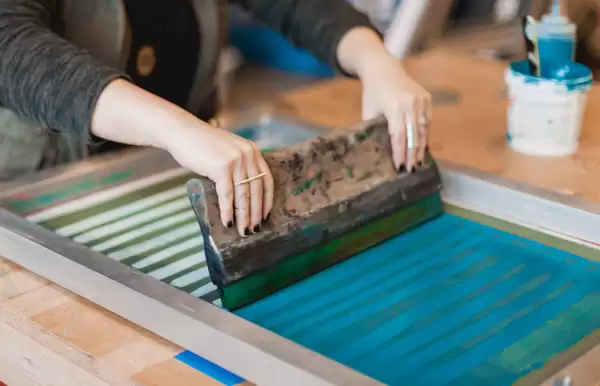Screen printing is a versatile and popular method for printing designs on various surfaces, from t-shirts and tote bags to posters and home décor. This comprehensive guide to screen printing will walk you through the methods, supplies, and success tips whether you’re an expert wishing to hone your craft or a novice eager to start a DIY project.
What is Screen Printing?
Screen printing, also known as silk screening, is a printing technique that involves pushing ink through a mesh stencil onto a surface. The process could be automated or human, depending on the scope of the project. Screen printing is popular because it produces vivid, durable colors, making it perfect for a variety of uses, from apparel to signage.
Essential Materials for Screen Printing
Before diving into the techniques, let’s go over the essential materials you’ll need for screen printing:
1. Screens
The screen is arguably the most crucial element in screen printing. It’s typically made of a wooden or aluminum frame with a mesh fabric stretched across it. The mesh count can vary, affecting the level of detail and ink coverage.
2. Squeegees
The ink goes through the screen using a squeegee. Choose from a range of sizes and hardness levels one that satisfies the demands of your project.
3. Inks
Screen printing inks come in various types, including water-based, plastisol, and solvent-based. The choice of ink will depend on the material you’re printing on and your desired finish.
4. Substrate
The substrate is the material you’ll be printing on. This could be anything from fabric and paper to wood and metal.
5. Other Supplies
Additional supplies include tape, emulsion, a dark room or exposure unit, and cleaning supplies for post-printing cleanup.
Screen Printing Techniques
1. Photo Emulsion Method
This is the most common technique, especially for intricate designs. A photo-sensitive emulsion is applied to the screen and exposed to light, hardening the areas that are not covered by your design. The unhardened areas are then washed out, leaving a stencil of your design on the screen.
2. Stencil Method
In this method, a stencil is cut out of paper or another material and placed under the screen. This is a quicker but less precise method, ideal for simple designs.
3. Drawing Fluid-Screen Filler Method
This technique involves drawing your design directly onto the screen with a fluid, then applying a screen filler to the rest of the screen. Once the fluid and filler are dry, the drawing fluid is rinsed out, leaving a stencil.
Tips for Successful Screen Printing
1. Test Print
Always do a test print on a scrap material to check for errors or issues before you start the actual printing.
2. Proper Ink Application
Ensure that you’re applying the ink correctly. Too much ink can lead to smudging, while too little may result in an uneven print.
3. Screen Tension
Maintaining proper screen tension is crucial for a clean print. A loose screen can result in blurry images.
4. Curing the Ink
Different inks have different curing requirements. Make sure to follow the manufacturer’s guidelines to ensure your print is durable.
5. Cleanup
Proper cleanup is essential for extending the life of your screen printing materials. Always clean your screen and squeegee immediately after use.
Common Challenges and Solutions
1. Ink Bleeding
If your ink is bleeding, it could be due to using too much ink or having a loose screen. Make sure your screen is taut and adjust your squeegee pressure.
2. Uneven Prints
This usually occurs when the screen is not making even contact with the substrate. Ensure that your screen is level and that you’re applying even pressure with the squeegee.
3. Design Not Transferring
If your design isn’t transferring properly, your screen might be too close to the substrate. A proper off-contact distance is crucial for a clean print.
Advanced Tips for Screen Printing Mastery
Once you’ve got the basics down, you might be interested in taking your screen printing skills to the next level. Here are some advanced tips for those looking to master the art of screen printing:
1. Multi-Color Printing
Printing with multiple colors adds complexity but also opens up a range of creative possibilities in custom-t-shirt-printing. You’ll need to make distinct screens for each hue and carefully align them to produce the desired design in order to complete this task successfully.
2. Experiment with Textures
Don’t limit yourself to flat, single-layer prints. Experiment with textures by layering different colors or using specialty inks like puff ink or metallics.
3. Master the Halftone Technique
Halftones allow you to create gradients and shades, adding depth to your designs. This technique requires a high mesh count and precise exposure times.
4. Optimize Your Workspace
A well-organized workspace can significantly impact your efficiency and the quality of your prints. Invest in quality tables, drying racks, and storage solutions to keep everything in its place.
5. Quality Control
As you scale up your screen printing efforts, quality control becomes increasingly important. Create a checklist for each stage of the process, from design creation to the final print, to ensure consistency.
The Business Aspect of Screen Printing
If you’re considering turning your screen printing hobby into a business, there are additional factors to consider:
1. Pricing Strategy
Understanding your costs is crucial for setting prices that are both competitive and profitable. Take into account the cost of materials, labor, and overheads when pricing your screen printing services.
2. Marketing
Utilize social media, online marketplaces, and local events to showcase your work and attract customers. Reaching a larger audience can also be accomplished by creating a portfolio website.
3. Customer Service
You may stand out from the competition by providing excellent customer service. Build a loyal client base by being accessible to questions, providing unique solutions, and making sure deliveries are made on time.
4. Legalities
Make sure to cover all legal aspects, including business registration, tax identification, and any necessary permits or licenses. When employing designs that are not your own, you should also be conscious of copyright regulations.








